All About Visiting Yellowstone in December
The benefits, drawbacks, activities and other features of visiting Yellowstone in December
Updated: 10/28/22
December in Yellowstone National Park is a winter wonderland— it is absolutely magical. Nothing beats the snowy meadows, hot steam rising from a geyser to meet with the bitterly cold air, or an icicle-covered bison trudging through a white plain. There are many benefits to visiting in February, as well as some drawbacks. If you can make it to Yellowstone in December, you will have a great trip, and leave with an appreciation for the snow and solitude of winter in the park.
Benefits of Visiting in December
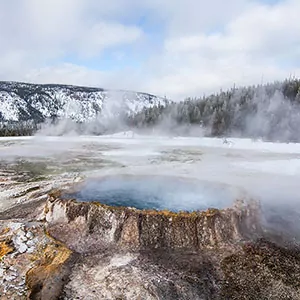 The biggest benefit of visiting in December is the wildlife viewing. Most animals make their way to the meadows and valleys because the high country is too cold in the winter. The high concentration of animals at lower elevation makes it much easier to view them—bison, bighorn sheep, wolves and elk are plentiful in the valleys. There are few things like seeing a 2000 pound bison, with icicles forming on its long “beard,” standing remarkably still to conserve energy and heat. The Lamar Valley, which has the only road open to wheel vehicles this time of year, is a great place to see bison and elk in large herds. Wolves can also be seen in this valley as they have come down from the high country to hunt the ungulates that gather here. The snow will benefit those wanting to see wildlife in two ways. The first is that many creatures with dark coats, such as many of Yellowstone’s wolves, will be easier to see from long distances away as they’ll stand in contrast to the white snow. The second benefit is that snow preserves foot prints and animal tracks far better than dirt, so you may get to see the evidence of some of the parks more elusive animals.
The biggest benefit of visiting in December is the wildlife viewing. Most animals make their way to the meadows and valleys because the high country is too cold in the winter. The high concentration of animals at lower elevation makes it much easier to view them—bison, bighorn sheep, wolves and elk are plentiful in the valleys. There are few things like seeing a 2000 pound bison, with icicles forming on its long “beard,” standing remarkably still to conserve energy and heat. The Lamar Valley, which has the only road open to wheel vehicles this time of year, is a great place to see bison and elk in large herds. Wolves can also be seen in this valley as they have come down from the high country to hunt the ungulates that gather here. The snow will benefit those wanting to see wildlife in two ways. The first is that many creatures with dark coats, such as many of Yellowstone’s wolves, will be easier to see from long distances away as they’ll stand in contrast to the white snow. The second benefit is that snow preserves foot prints and animal tracks far better than dirt, so you may get to see the evidence of some of the parks more elusive animals.
Another benefit to visiting in December is the lack of crowds. The month of July sees 4 million visitors, while the entire season of winter only sees .3 million. Because there are fewer people, your chances for solitude grow exponentially. This means that you are much less likely to run into long lines of traffic, extended waits for services, or crowds around the famous sites. Fewer visitors also means that accommodations will be more available and better priced than during the summer. You’ll probably still be able to find somewhere to stay even a few weeks before your travel date. There are two lodges within the park that can remain open in the winter. The one at Mammoth Hot Springs you can access by car, but the other at Old Faithful must be accessed with over snow vehicles such as snowmobiles or snow coaches after over the snow travel begins on December 15.
Visiting Yellowstone in the winter is an extremely different experience than visiting any other time of year; you will see the park in a way that very few people do. Perhaps a benefit that is almost too obvious to mention is the sheer beauty of the landscape at this time of year. If you think that Yellowstone is beautiful in the summer (which it is), you may find it even more remarkable in the winter as the brightly colored hot spring waters and the wildlife’s dark coats stand out against the white snow.
Drawbacks of Visiting in December
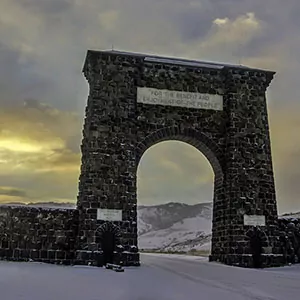 One of the biggest drawbacks to visiting the park in December is that most of the roads are closed to private vehicles. The only road that is open for visitors to drive themselves is the road from the north entrance, at Gardiner, to the northeast entrance, at Cooke City. Snow coach transportation is available later in the month if you want to get deeper in to the park. While many people find this mode of transportation novel compared to driving a private vehicle, it can be cumbersome, time-consuming, and expensive. Over snow transportation typically does not open in the park until December 15, so if you visit before that date you will not be able to access any of the southern portion of the park. Thus the only road open to any kind of travel for the first half of the month is the road in the north that takes you to Mammoth Hot Springs, Lamar Valley, and the tower area. This is a huge drawback to December as much of the park, including many of the famous sites will be entirely inaccessible for the first half of the month. This is to prepare the roads for the opening of over snow travel and to make sure that the snow pack is deep enough to allow snowmobiles and now coaches. You can check the year by year road conditions here.
One of the biggest drawbacks to visiting the park in December is that most of the roads are closed to private vehicles. The only road that is open for visitors to drive themselves is the road from the north entrance, at Gardiner, to the northeast entrance, at Cooke City. Snow coach transportation is available later in the month if you want to get deeper in to the park. While many people find this mode of transportation novel compared to driving a private vehicle, it can be cumbersome, time-consuming, and expensive. Over snow transportation typically does not open in the park until December 15, so if you visit before that date you will not be able to access any of the southern portion of the park. Thus the only road open to any kind of travel for the first half of the month is the road in the north that takes you to Mammoth Hot Springs, Lamar Valley, and the tower area. This is a huge drawback to December as much of the park, including many of the famous sites will be entirely inaccessible for the first half of the month. This is to prepare the roads for the opening of over snow travel and to make sure that the snow pack is deep enough to allow snowmobiles and now coaches. You can check the year by year road conditions here.
In addition, not all the lodges and accommodations are open during winter, so the fewer people having fewer options might make some of the accommodations feel like the crowds are equivalent to summer. You also may have to plan your food and activities more carefully as not all the eateries and visitor centers are open.
The snow in Yellowstone is beautiful, but it is a double edged sword causing many of the roads to close, and the road that is open to be icy and treacherous. The weather also makes visitors bear up under subzero temperatures, whipping winds, and sometimes snow storms and white outs. This means that visitors will need to be prepared with better and more equipment if they choose to visit the park this time of the year. December in Yellowstone is no joke, and those who come unprepared will be miserable at best and in danger of frostbite and hypothermia at worst. Blizzards and white outs also pose the possibility of being stuck inside the lodge for a few days, so make sure to bring a deck of cards or a good book in case you are literally prevented from going outside because of the weather. The shorter winter days will also limit your activities as the temperature drops sharply after the sun goes down and you will not want to be caught in the elements after dark. This leaves only a few hours while the winter sun warms the park enough to be outside.
Things To Do In December
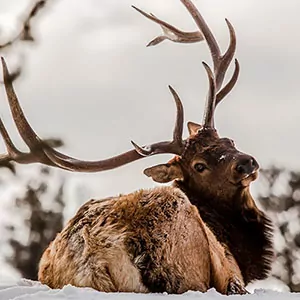
Many trails at lower elevation are open in the winter, giving you the chance to explore via snowshoe or cross country ski. Snowshoes and skis are available to rent at Mammoth Hot Springs and Old Faithful. Snowshoe tours and cross country ski tours are also available, and give you a unique perspective of the park—highlighting geysers, frozen waterfalls and abundant wildlife in snow-covered meadows. With the logistics taken care of and the knowledge from a Yellowstone expert, you’re sure to enjoy these guided trips. The Grand Canyon of Yellowstone, only accessible by over snow travel after December 15, boasts great snowshoeing and cross country ski trails. Make sure to check with ranger at the visitor center to learn about which trail would be best for you based on current conditions and your skill level. Backcountry camping is possible in Yellowstone in the winter, but it’s only for those who are experienced and have the gear to make such a trip safe.
Many companies offer snow coach transportation from any entrance of the park to Old Faithful or the Grand Canyon of Yellowstone. Some companies also offer snowmobile tours, and the National Park Service has a lottery system for a Non-Commercially Guided Snowmobile Access Program —where visitors over the age of 18 can snowmobile through the park without a commercial guide. These are wonderful ways to explore the park further, since you can’t drive the road yourself. Again, these activities are only available after December 15, so if you are in the park before this date you will have to make do with the road from the north entrance to the north east entrance, as it will be the only one available. Sightseeing and photography are very popular options in winter, even if you visiting the park before the opening of over snow travel. Mammoth Hot Springs and Lamar Valley are brimming with wildlife and beautiful sights that are all wonderful photography subjects. Large herds of bison, packs of wolves, pure white snowshoe hares and long tailed weasels bounding across the snow, and coyotes and foxes plunging headfirst into the powder hunting for voles are all amazing sights, and definitely worth your pictures. If you’re in the park after the 15th, the southern hydrothermal features in the park have an especially ethereal look to them when surrounded by snow.
If the weather prevents you from spending time outside (which is not entirely out of the question), the Old Faithful Visitor Center and Museum is open in December and the Albright Visitor Center near Mammoth Hop Springs is open year round. The partially indoor, partially outdoor Grizzly and Wolf Discovery Center, just outside the west entrance of the park is also a great option as an accredited and non-profit zoo. This is your best chance for seeing bears in December as the bears in the park hibernate but the bears in the center do not.
Things to see in december
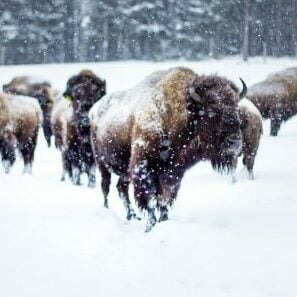 December is a fantastic time for sight seeing in Yellowstone as all the famous sights are cloaked in a mantle snow and take on an other-worldly look. However, some of your sightseeing might be impeded by the fact that the parks roads, besides the road from the north entrance to the north east entrance, are inaccessible to both private vehicles and over snow travel for the first half of the month. However, this doesn’t mean that visiting Yellowstone during this time isn’t worthwhile. Below we put together a list of some of the must-see sights in December along with an indication of whether or not they’re available during the first half of the month. The list is by no means exhaustive, so make sure to do your own research about what specifically piques your interest in the park.
December is a fantastic time for sight seeing in Yellowstone as all the famous sights are cloaked in a mantle snow and take on an other-worldly look. However, some of your sightseeing might be impeded by the fact that the parks roads, besides the road from the north entrance to the north east entrance, are inaccessible to both private vehicles and over snow travel for the first half of the month. However, this doesn’t mean that visiting Yellowstone during this time isn’t worthwhile. Below we put together a list of some of the must-see sights in December along with an indication of whether or not they’re available during the first half of the month. The list is by no means exhaustive, so make sure to do your own research about what specifically piques your interest in the park.
Old Faithful: The most famous geyser in the world, Old Faithful is a must see anytime you visit Yellowstone, no matter how many times you’ve seen it before. One of the few geysers that erupts consistently and predictably, Old Faithful has been wowing visitors for decades. Check the visitor center near the Old Faithful geyser basin for predictions on what time the geyser will eurpt, and then wait for this wonder of nature to spew hundreds of gallons of boiling water into the air. Accessible only by over snow travel after December 15
Lamar Valley: Lying along the only road that is open to private vehicles in the winter, Lamar Valley is a fantastic place to view wildlife and take in the majestic vistas of Yellowstone. Hundreds of bison gather here for the warmer temperatures and more readily available food, and this valley is also your best opportunity to see wolves that come down from the high country for the same reasons as the ungulates that they hunt. Make sure to drive carefully on the road though, as the bison see the advantages of walking along the paved road instead of trudging through the snow. Accessible throughout winter in private vehicles
Mammoth Hot Springs: One of the most unique hydrothermal features in the park, Mammoth Hot Springs is often described as more beautiful than any fountain man could have designed. Instead of lying in pools like many hot springs, the superheated water of Mammoth runs over terraces of limestone, tinged with burnt orange and white, that have been formed from long years of mineral rich water bubbling up from beneath the earth’s crust. Accessible throughout winter in private vehicles
Yellowstone Lake: The largest alpine lake in the country, Yellowstone lake has over 100 miles of shoreline, all of which is packed with wildlife, hydrothermal features, and great hiking trails. Much of the lake will be edged with snow this time of year, and there are great opportunities for snowshoeing and cross-country skiing. Although the lake will probably be frozen over by December, is not recommended to walk on the ice as it still may be thin is time of year. Accessible only by over snow travel after December 15
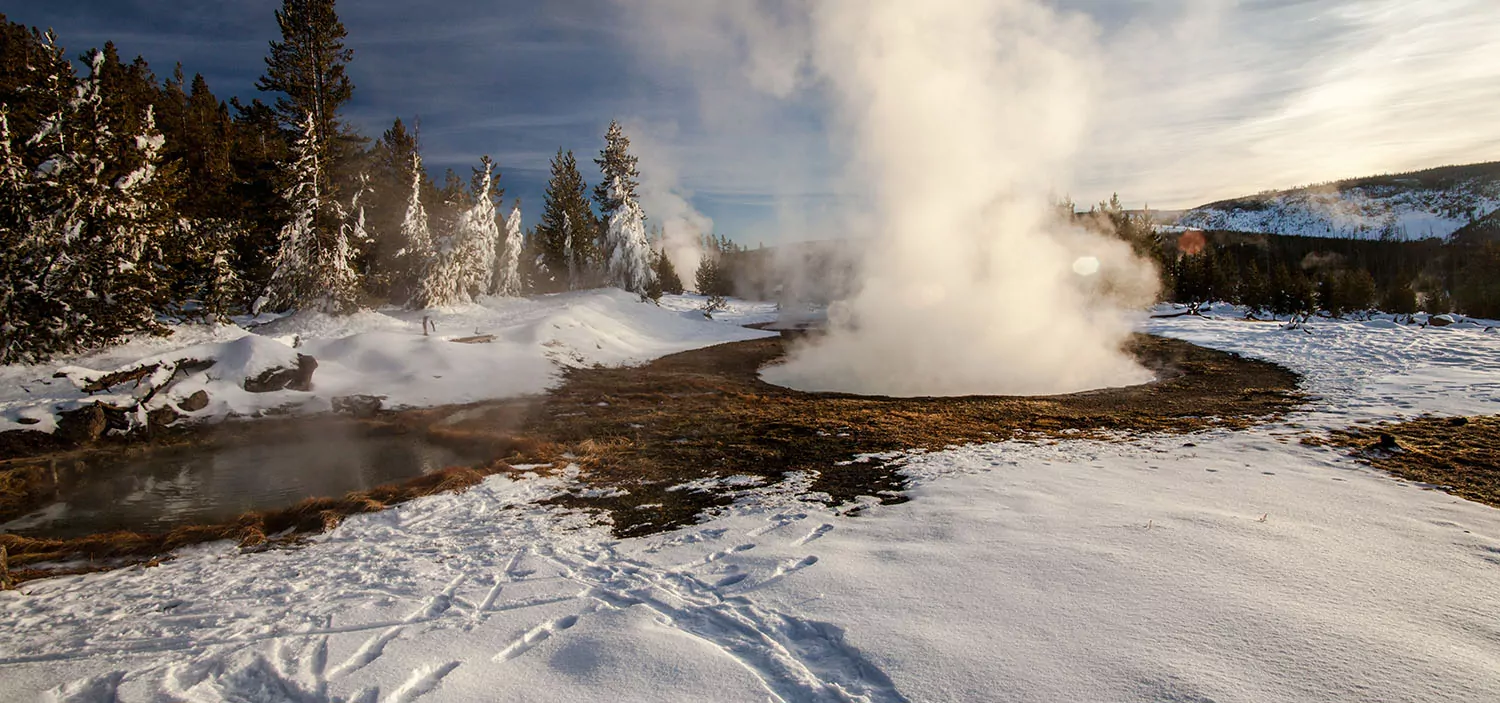
Hiking in December
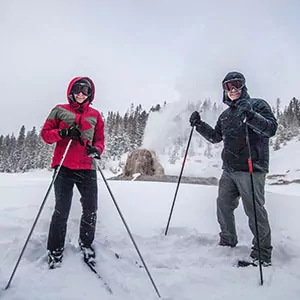 Typically, there is a lot of snow in Yellowstone in December, so you’ll probably be hiking with more than just your hiking boots and trekking poles. Snowshoeing and cross country skiing are incredible ways to experience the backcountry of Yellowstone in the winter. Many trails are open for these activities in Mammoth Hot Springs, Old Faithful and the Grand Canyon of Yellowstone. Winter guided tours are a great way to experience the park—with gear provided, and lodging and transportation included, you can relax and enjoy Yellowstone in a way that few others do.
Typically, there is a lot of snow in Yellowstone in December, so you’ll probably be hiking with more than just your hiking boots and trekking poles. Snowshoeing and cross country skiing are incredible ways to experience the backcountry of Yellowstone in the winter. Many trails are open for these activities in Mammoth Hot Springs, Old Faithful and the Grand Canyon of Yellowstone. Winter guided tours are a great way to experience the park—with gear provided, and lodging and transportation included, you can relax and enjoy Yellowstone in a way that few others do.
The Canyon Rim Ski Trail for cross country skiing is a great option for those looking for unique views as a 4.5 mile moderate ski around the rim of the Grand Canyon of Yellowstone. Alternatively, there is the North Canyon Trail along the Grand Canyon of Yellowstone that is also moderate but shorter, coming in at 3 miles. If you’re looking for something on the easier side, Cascade Lake Ski Trail and Old Canyon Bridge Ski Trail are both great options. Always ask a ranger before setting out on a trail about the conditions and the skill level required for completing it. Snowshoers are asked not to walk directly in ski tracks as the indentations can pose dangers to skiers. Neither skiers nor snowshoers should remove their foot gear and walk on the trail in only their boots as these indentations can also be dangerous. If you fall, fill in the hole that you made, so that others won’t fall into it as well. While out there are many trails in the park that offer excellent opportunities for these sports, bear in mind which ones will be an available to drive to and which ones will only be available after December 15 when over snow travel opens.
Skiers and snowshoers should be aware of the dangers they might encounter while out on the trail. Winter in Yellowstone can be brutal, and no one should not venture into the back country without adequate preparation and knowledge. Frostbite, hypothermia, and overheating are your biggest dangers due to dressing inappropriately. Overheating can indeed be a danger for those that do not dress in layers, but dress too warmly and do not have any layers to remove without becoming too cold. Make sure to have a good base layer next to your skin, a warm fleece or down jacket, and a waterproof shell to keep the wind and snow off of you. Also make sure to drink plenty of water even though it is cold, and carry it in insulated containers so that it does not freeze. Most cases of hypothermia occur in the park when the temperature is between 30° and 50° due to visitors becoming chilled, so make sure to put on your snow gear before you get wet and break out your warm layers before you start shivering. Wildlife can also be dangerous in winter. Although bears are hibernating, it is not impossible for them to leave their dens and for visitors to see them. Bison, however, have injured more people in the park than any other animal, so it is important not to approach these multi ton animals that can run faster than you. All those in the back country– even those on a day hike– should have navigational equipment, as many winter trails are not marked and can be difficult to navigate especially in snowstorm or white out conditions. Even if it is not actively snowing, you should never rely on your footprints to lead you back to the trail head. Hydrothermal areas, avalanches, and post-holing are all also risks that hikers need to be aware of. Check the forecast and talk to a ranger before you head out on a hike to make sure that the trail is appropriate for your skill level and that the conditions are fair enough to hike.
backpacking in december
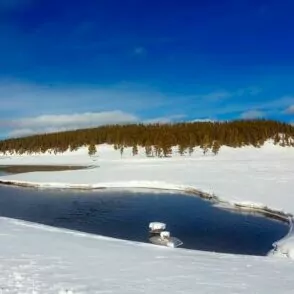 Traditional backpacking in Yellowstone in December is not possible due to snow, but brave (and experienced) hikers can embark on a winter backpacking trip if the weather allows in December, although not without some additional risk. Winter camping in the backcountry in Yellowstone can be very dangerous and it is important that those who participate in this activity are prepared for what they might encounter. However, even though December is winter in Yellowstone, those thinking about backpacking in December might want to push their trip later in the winter for a couple different reasons. The first is that you are taking a chance in December of there being enough snow. Winter backpacking involves cross country skiing or snowshoeing, neither of which you can do if the ground is only partially covered in snow. Those in the backcountry cannot take both fall and winter equipment on their trip, and since you have to book permits months in advance, you will not know what the snow pack will be like until you arrive. Secondly, half of the park is closed until December 15th to any kind of travel whatsoever, so many trails will be inaccessible. While there are some options starting from Lamar Valley, make sure to check online and with a ranger about what areas are closed for wildlife or bear management as this valley is home to lots of wildlife in winter.
Traditional backpacking in Yellowstone in December is not possible due to snow, but brave (and experienced) hikers can embark on a winter backpacking trip if the weather allows in December, although not without some additional risk. Winter camping in the backcountry in Yellowstone can be very dangerous and it is important that those who participate in this activity are prepared for what they might encounter. However, even though December is winter in Yellowstone, those thinking about backpacking in December might want to push their trip later in the winter for a couple different reasons. The first is that you are taking a chance in December of there being enough snow. Winter backpacking involves cross country skiing or snowshoeing, neither of which you can do if the ground is only partially covered in snow. Those in the backcountry cannot take both fall and winter equipment on their trip, and since you have to book permits months in advance, you will not know what the snow pack will be like until you arrive. Secondly, half of the park is closed until December 15th to any kind of travel whatsoever, so many trails will be inaccessible. While there are some options starting from Lamar Valley, make sure to check online and with a ranger about what areas are closed for wildlife or bear management as this valley is home to lots of wildlife in winter.
Backpacking in winter can be a very rewarding activity, but it can also can be very dangerous. The National Park’s Service has put together a great video and page on their website that talks about the risks of this activity as well as giving tips and tricks on how to make your trip more enjoyable. Everything that endangers day hikers is amplified for backpackers, so make sure you read the above section about the risks associated with hiking in general. Snowstorms, subzero temperatures, whipping winds, trails covered in snow, wildlife, avalanches, hypothermia, frostbite, overheating, frozen lakes, dangerous snow bridges, hydrothermal areas, post-holing, equipment malfunction, and a variety of other dangers all pose threats to those in the backcountry. Although it is not for everyone, you shouldn’t be turned away from this kind of adventure completely. It’s best to go with a guiding company for your first time and get to know what winter camping is like.
Weather in December
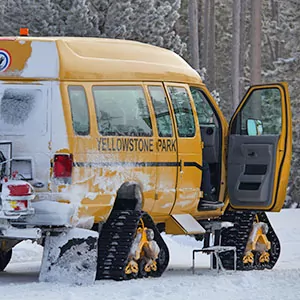 Yellowstone is a large park with 3,471 square miles of land and elevations ranging from 6,000 to 11,000 ft. Thus the weather your experience will depend greatly on where you are and what elevation you are at. Much of the high country in December, however, is inaccessible due to snow. Generally, the weather in December in Yellowstone is cold and snowy. Average temperatures for Mammoth Hot Springs are a high of 30, and a low of 12 degrees Fahrenheit (-1/ -10 degrees Celsius). At Old Faithful, average temperatures are a high of 27, and a low of 0 degrees Fahrenheit (-3/ -17 degrees Celsius). On average there are 10 days of snow in Yellowstone in December. Visitors should keep in mind that these temperatures are only the averages and that the park can receive much warmer–or much colder– temperatures than these. It is not uncommon for those backpacking to encounter temperatures of -20 degrees or colder.
Yellowstone is a large park with 3,471 square miles of land and elevations ranging from 6,000 to 11,000 ft. Thus the weather your experience will depend greatly on where you are and what elevation you are at. Much of the high country in December, however, is inaccessible due to snow. Generally, the weather in December in Yellowstone is cold and snowy. Average temperatures for Mammoth Hot Springs are a high of 30, and a low of 12 degrees Fahrenheit (-1/ -10 degrees Celsius). At Old Faithful, average temperatures are a high of 27, and a low of 0 degrees Fahrenheit (-3/ -17 degrees Celsius). On average there are 10 days of snow in Yellowstone in December. Visitors should keep in mind that these temperatures are only the averages and that the park can receive much warmer–or much colder– temperatures than these. It is not uncommon for those backpacking to encounter temperatures of -20 degrees or colder.
These extreme temperatures and unpredictable weather and systems make the park cumbersome to travel to in December, requiring more and better gear and clothing. For the first half of the month, only one road from the north entrance to the north east entrance is open to wheeled vehicles in the park. Over snow travel on the rest of the roads does not typically open until December 15, so for the first half of the month most of the park is inaccessible. If you drive the road that is open through Mammoth Hot Springs and the Lamar Valley, it is important to drive slowly and safely as the road can be icy and you will be sharing it with wildlife who see the advantage of walking along the paved road instead of trudging through deep snow. Visitors in the winter should also be aware that the weather may very well prevent you from being outside. Snowstorms and white out conditions can last for days, so it’s best to bring a good book or some board games to keep you busy in the lodge if the weather prevents you from being outdoors. Despite all the snow, Yellowstone is very dry and lacks humidity. Those accustomed to living in humidity who visit the park should be prepared for this, bring lots of lotion, and not be surprised if the skin on their hands and feet becomes dry or even starts to crack. All visitors should be aware of the increased elevation of Yellowstone and the smaller amount of oxygen in the air that makes strenuous activities even harder. You may find a hike that you could easily do at home to quickly make you out of breath and tired. If you are in the park for more than a few days, you should acclimate to the elevation, but be aware of your limits. Yellowstone’s winters can be brutal, and those that come unprepared will at best be miserable and cold and at worst be in danger of frostbite and hypothermia. Make sure you know how to prepare for winter so that your trip will be the enjoyable winter wonderland you want it to be.
Wildlife in December
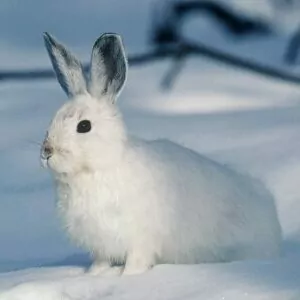 December is a great time to see wildlife in the park as many species are gathered in the low lands and valleys for the (relatively) warmer temperatures and the more readily available food. The staple creatures, bison and elk, can be seen in great numbers in the Lamar Valley and in Mammoth Hot Springs respectively. These creatures will often walk on the roads as they see the benefit of paved roads instead of losing heat and energy while trudging through deep snow. The other Yellowstone wildlife icon however, the grizzly bear, along with its cousin the black bear will both be in hibernation this time of year. Although it is not impossible for them to leave their dens and for visitors to see them, it’s very unlikely. However, you should still practice good food storage, as there are many other predators in the park that would love to get their paws on your lunch, mainly wolves, bobcats, coyotes, mountain lions, and badgers. These more elusive predators are not often seen by visitors, but the winter months are more likely to give a visitor a sighting– of at least a foot print or two– of one of these animals as they’re willing to come into the low country where their prey is, there are fewer people to scare them away, and the snow preserves their footprints much better than dirt. Many of the other animals in the park are a joy to watch, especially rodents and members of the weasel family. Beavers don’t hibernate, but only patient visitors will see them as they are usually active around dusk and dawn and occupy pools that are too deep to freeze completely, gaining access to their dams underwater. River otters can also be seen in winter, often sledding on their bellies down into the water. Long tailed weasels and snowshoe hares turn pure white in winter and can be seen bounding across the snow. Trumpeter swans, common loons, golden eagles, and osprey are only a few of the birds that inhabit the park. Snow buntings usually gather in large flocks and their characteristic black, brown, and white feathers make for great pictures, but make sure to be quick as these birds usually fly to a new location within 10 minutes or so and are rather restless in winter.
December is a great time to see wildlife in the park as many species are gathered in the low lands and valleys for the (relatively) warmer temperatures and the more readily available food. The staple creatures, bison and elk, can be seen in great numbers in the Lamar Valley and in Mammoth Hot Springs respectively. These creatures will often walk on the roads as they see the benefit of paved roads instead of losing heat and energy while trudging through deep snow. The other Yellowstone wildlife icon however, the grizzly bear, along with its cousin the black bear will both be in hibernation this time of year. Although it is not impossible for them to leave their dens and for visitors to see them, it’s very unlikely. However, you should still practice good food storage, as there are many other predators in the park that would love to get their paws on your lunch, mainly wolves, bobcats, coyotes, mountain lions, and badgers. These more elusive predators are not often seen by visitors, but the winter months are more likely to give a visitor a sighting– of at least a foot print or two– of one of these animals as they’re willing to come into the low country where their prey is, there are fewer people to scare them away, and the snow preserves their footprints much better than dirt. Many of the other animals in the park are a joy to watch, especially rodents and members of the weasel family. Beavers don’t hibernate, but only patient visitors will see them as they are usually active around dusk and dawn and occupy pools that are too deep to freeze completely, gaining access to their dams underwater. River otters can also be seen in winter, often sledding on their bellies down into the water. Long tailed weasels and snowshoe hares turn pure white in winter and can be seen bounding across the snow. Trumpeter swans, common loons, golden eagles, and osprey are only a few of the birds that inhabit the park. Snow buntings usually gather in large flocks and their characteristic black, brown, and white feathers make for great pictures, but make sure to be quick as these birds usually fly to a new location within 10 minutes or so and are rather restless in winter.
recommended wildland trips in december
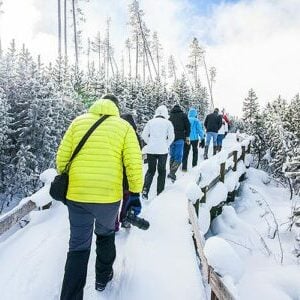 Planning out a vacation to Yellowstone in January can be a headache as you try to keep up with the current conditions, openings, closures, weather, and everything else that goes into a trip in winter. Instead of going through all that hassle, an alternative is to book a trip with Wildland Trekking and let us worry about all the logistics and details. Allow one of our expert guides to show you around the park on one of the many trips we offer to Yellowstone in a variety of styles that include backpacking, basecamp tours, inn based tours, llama treks, and day hikes. Unfortunately, the weather in December makes many of these styles unpractical. But we do offer an inn based tour that perfectly combines cozy and rustic accommodations with snowshoeing in Yellowstone’s great white wilderness. Our Yellowstone Snowshoe Traverse will allow you to experience the peace and quiet of winter in the park on an either a 4 or 5 day trip full of snowshoeing and enjoying the scenery. You don’t need any prior experience to embark on the snowshoeing treks we will take during the day before returning to our cozy lodge accommodation in the evening for showers, relaxation, and hearty meals. As all of our trips are, this trip is all inclusive so you don’t have to worry about meals, local transportation, lodging, or much of your equipment including snowshoes. We take care it all for you. Whether you’re looking to come to Yellowstone in the winter for the first time or the hundredth time, you won’t regret coming on this fantastic adventure.
Planning out a vacation to Yellowstone in January can be a headache as you try to keep up with the current conditions, openings, closures, weather, and everything else that goes into a trip in winter. Instead of going through all that hassle, an alternative is to book a trip with Wildland Trekking and let us worry about all the logistics and details. Allow one of our expert guides to show you around the park on one of the many trips we offer to Yellowstone in a variety of styles that include backpacking, basecamp tours, inn based tours, llama treks, and day hikes. Unfortunately, the weather in December makes many of these styles unpractical. But we do offer an inn based tour that perfectly combines cozy and rustic accommodations with snowshoeing in Yellowstone’s great white wilderness. Our Yellowstone Snowshoe Traverse will allow you to experience the peace and quiet of winter in the park on an either a 4 or 5 day trip full of snowshoeing and enjoying the scenery. You don’t need any prior experience to embark on the snowshoeing treks we will take during the day before returning to our cozy lodge accommodation in the evening for showers, relaxation, and hearty meals. As all of our trips are, this trip is all inclusive so you don’t have to worry about meals, local transportation, lodging, or much of your equipment including snowshoes. We take care it all for you. Whether you’re looking to come to Yellowstone in the winter for the first time or the hundredth time, you won’t regret coming on this fantastic adventure.
Join a Guided Hiking Adventure
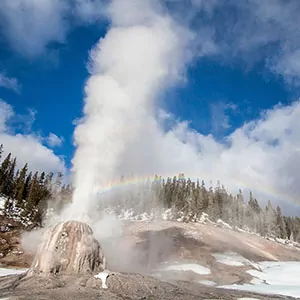 Yellowstone National Park is home to some of the most epic and amazing hiking vacations in the world. Wildland Trekking offers trips with the best of Yellowstone: geysers, waterfalls, views, wildlife, solitude, adventure and fascinating natural and cultural interpretation.
Yellowstone National Park is home to some of the most epic and amazing hiking vacations in the world. Wildland Trekking offers trips with the best of Yellowstone: geysers, waterfalls, views, wildlife, solitude, adventure and fascinating natural and cultural interpretation.
Guided Yellowstone treks are all-inclusive which covers permits; local transportation (excluded on certain tours); meals; equipment; safety systems and professional hiking/wilderness guides; all of which allows visitors to maximize their time in Yellowstone and focus entirely on enjoying the Park.
YELLOWSTONE ADVENTURE TOURS
- GUIDED BACKPACKING ADVENTURES: these are for people interested in an authentic Yellowstone adventure away from the roads and crowds.
- LLAMA TREKS: on these innovative trips, guests hike with light day packs and camp near in stunning backcountry locations.
- INN-BASED PACKAGES: these tours are all-inclusive packages with lodging, amazing daily hikes, expert guides, meals, transportation and more!
- CAMPING-BASED HIKING PACKAGES: camping-based hiking packages provide all-around hiking experiences of Yellowstone on wonderful outdoor vacations.
- DAY HIKE TOURS: maximize your day in Yellowstone on a fully guided, award-winning hiking tour on one of the Park’s best trails.





